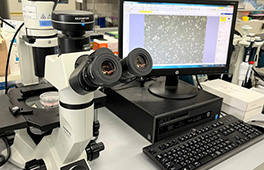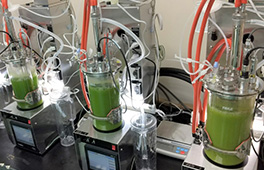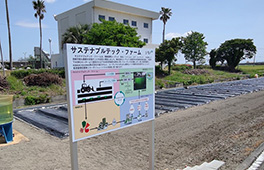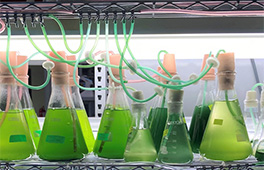Research content
We are conducting research aimed at developing new uses for microalgae, such as searching for new useful microalgae, breeding using genetic engineering technology, and developing culture methods that are expected to be used in the next generation. In addition, by incorporating cutting-edge science and technology through joint research with universities and other companies, we aim to contribute widely to the development of new materials, the improvement of product value, and the reduction of production costs. Furthermore, in anticipation of future utilization, it was derived such as demonstration of cultivation of microalgae Euglena on low-orbit satellites, study of resource recycling method by culture of microalgae in space, application development of comprehensive analysis technology of sulfur compounds, etc. We are also conducting research on the contents.

Message from the director

Our strengths are the know-how of mass culture of microalgae, breeding, and commercialization of produced algae. At the Institute of Advanced Sciences, the main task is to create new utilization methods while strengthening these strengths. In particular, regarding the improvement of microalgae varieties, I feel that we are in an era where technically difficult things can be realized, and we are promoting practical breeding and algae that can be used in various situations. We would like to provide strains and culture methods specialized for those strains. Since microalgae photosynthesize, they have a unique metabolic system that is different from other already industrially used heterotrophs, and are rich in nutrients. We would like to propose advanced utilization methods that take advantage of the characteristics of these microalgae.
Advanced Science Research Institute
Director Yasushi Yamada
Research case introduction
Utilization of Euglena genome editing technology

In collaboration with RIKEN, the genome editing technology for the microalgae Euglena has been completed, and it has become possible to freely rewrite the genome of Euglena. By utilizing this technology, it has become possible to freely modify the Euglena genome, and we are trying to produce various breeding strains.
- Research content
-
The breeding technology realized by the microalgae Euglena is extremely efficient because more than 70% of the cells of the treated Euglena population are modified despite genome editing that introduces a complex of RNA and protein. .. From this, it is possible to easily carry out genome modification so that the appearance does not change. We have also realized the application of applied methods such as the introduction of large deletion regions and the introduction of short foreign DNA sequences.
Click here for the release at the time of publication of the paper
There are still some hurdles to industrial use of the produced strains, but we are conducting research and development with the aim of producing strains with high fat and oil productivity, strains with high value as feed, and strains with high accumulation of useful ingredients. I am.

ゲノム編集によるDNA塩基配列改変のイメージ
Analysis of Euglena 's sulfur compound metabolism

When the microalgae Euglena produces fats and oils, it produces an odor that is thought to be derived from sulfur compounds, but the metabolic pathways known so far have not been able to explain this phenomenon. To clarify this, we conducted an analysis of sulfur compound metabolism.
- Research content
-
The sulfur metabolism system is attached to the central metabolism system such as glycolysis and TCA cycle, and although the number of constituent compounds is small, it provides very important information by analysis. By using the sulfur index, which is our patented technology, we can obtain information on the amount of these sulfur metabolism system compounds and the amount of polysulfide compounds that strongly reflect the redox state of living organisms.
The microalga Euglena accumulates fats and oils in the form of wax esters when oxygen in the environment is insufficient. When the intracellular state at this time is analyzed by the sulfur index, glutathione and proteins are decomposed and supplied sulfur compounds. Was observed to be metabolized. This will clarify a part of the cause of the odor generated when Euglena produces fats and oils, and it is expected that it will lead to the improvement of the production process and the presentation of breeding methods in the future.Click here for the release at the time of publication of the paper

油脂生産時にユーグレナ細胞内で起こる
硫黄化合物代謝の変化




